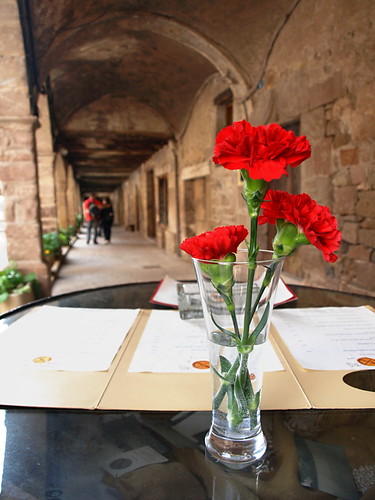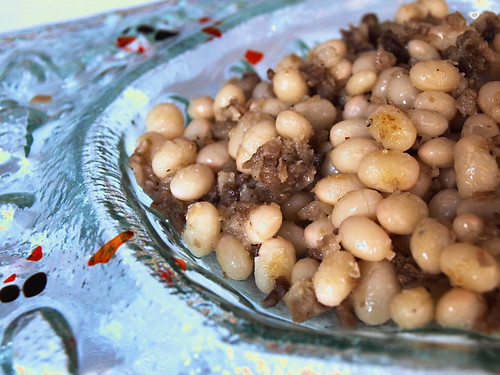In the cobbled streets of Santa Pau, the child unnerves me. There is something rather desolate about her stance; shoulders slumped and head drooping. It is the look of a skin and bone waif who knows hope lies beyond her grasp.
She’s tiny but there’s something about her that is quite creepy. If I’d met her in dusk’s hazy light, she would have made the hackles on my neck stand to attention. In the safety of the afternoon sun she merely unnerves…and intrigues.
The child is a bronze sculpture that stands without fuss at the side of one of the narrow, cobbled streets in the medieval village of Santa Pau in Costa Brava and the Pirineu de Girona.
There are others like her, unobtrusive bronze works of art created by international artists, that add a curious touch to Santa Pau’s medieval streets.
I’m captivated by Santa Pau before I set foot on it’s ancient cobbles. The village rises above the green countryside, teasing the eye with promise; the solid stone walls of its houses, church and tower look as though they have been steeped in centuries of history and tradition. Santa Pau must be a favourite for film-makers who don’t want to spend a fortune recreating an authentic looking medieval setting.
The approach to the village reinforces the sensation of touching the past; we enter via a footpath through the woodlands and a thigh-testing set of warped stone steps that lead to the cobbled street that is home to the bronze waif.
There is little time to absorb the prettiness of the old, crooked buildings as we’re hurried along to the La Placeta dels Balls, Santa Pau’s enclosed main square bordered by houses with long wooden balconies and arched porticoes, the 13th century castle of Holy Pau and the 15th century Gothic church of Santa Maria with its square tower.
In the centre of the aptly named La Placeta dels Balls (square of the dances), men dressed in black cloaks and top hats and women wearing white lace shawls and long skirts perform a traditional courtship dance. It is remarkably restrained and has more in common with traditional northern European dances than the more vibrant eastern influences seen in dances in southern Iberian regions.
A short tour of Santa Pau (it’s not big, so any tour isn’t going to take long) reveals a network of medieval streets that occasionally open out to reveal views of an unspoiled and tree-carpeted volcanic countryside; Santa Pau lies in the centre of the volcanic area of Garrotxa. It’s a great base for outdoor exploration and activities.
It’s a peach of a place and demands more time than I unfortunately have. We’re shown around the Hotel Cal Sastre which is one of those places where even after scouring Thesaurus, the only word that seems to fit snuggly is eclectic. The décor and furnishings range from antique to quirky (mannequins holding trays of sweets) to contemporary art on the walls and a vibrator shaped sculpture that draws sniggers…from those with a schoolboys sense of humour (guilty as accused).
The bar is one of those where I could see myself whiling away hours talking nonsense. A narrow staircase behind the bar leads to one of the bedrooms; this is the place I’d choose to sleep.
The hotel’s proprietors are also owners of the Restaurant Cal Sastre, our lunch venue.
The décor inside Restaurant Cal Sastre pays homage to Santa Pau’s past using pictures, magazine cuttings and old calenders, again it has the sort of ambience where hours dissolve like a snowflake on the fingertips.
However, our table is outside in the cool shade of the old portico beside the main square.
Our menu follows a culinary path that is much like Santa Pau itself – a strong and proud sense of the traditional with a few imaginatively artistic touches thrown in to surprise. A contemporary appetiser of olives encased in a gold jelly is followed by els fesols de Santa Pau (small beans grown locally). The traditional is mixed with contemporary even within the same dish; the sweet morcilla is a modern take on the classic Spanish blood sausage whilst crepes in a creamy sauce are filled with savoury sausage-meat.
We finish a long leisurely lunch with little trays of hand-made chocolates that could have come straight from the pages of Joanne Harris’ sinfully delicious novel.
In a way they are the perfectly symbolic conclusion to our brief visit to Santa Pau; one delicate bite leaves you craving for an awful lot more.
Buzz Trips visited Santa Pau and Restaurant Cal sastre as a guest of Costa Brava Tourist Board.
Jack is co-owner, writer and photographer for BuzzTrips and the Real Tenerife series of travel websites as well as a contributor to lots of other places. Follow Jack on Google+










Gràcias por vuestra visita, esperamos que nos tengais en buen recuerdo.
Como siempre fue un placer.
Thanks !
De nada 🙂